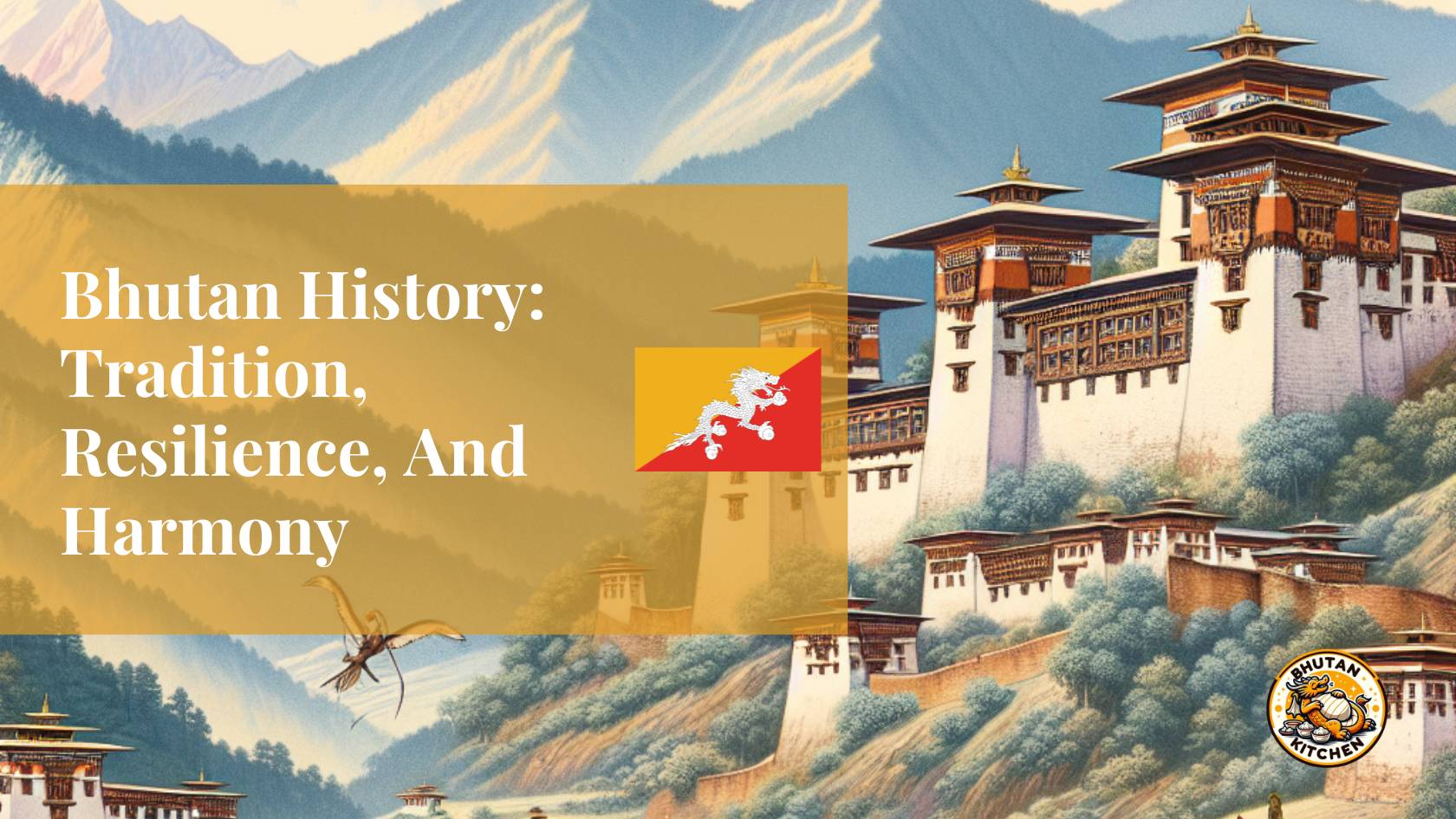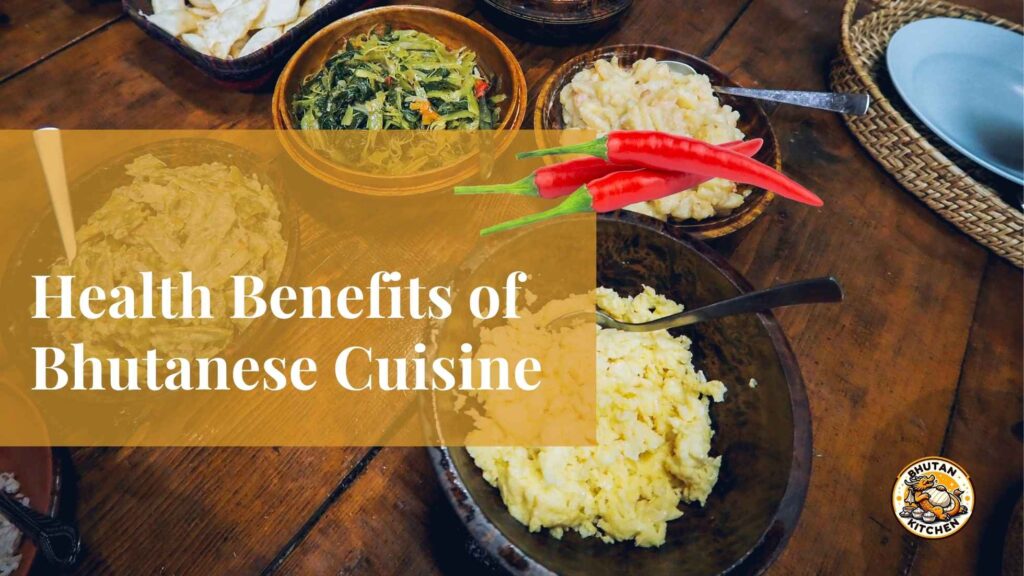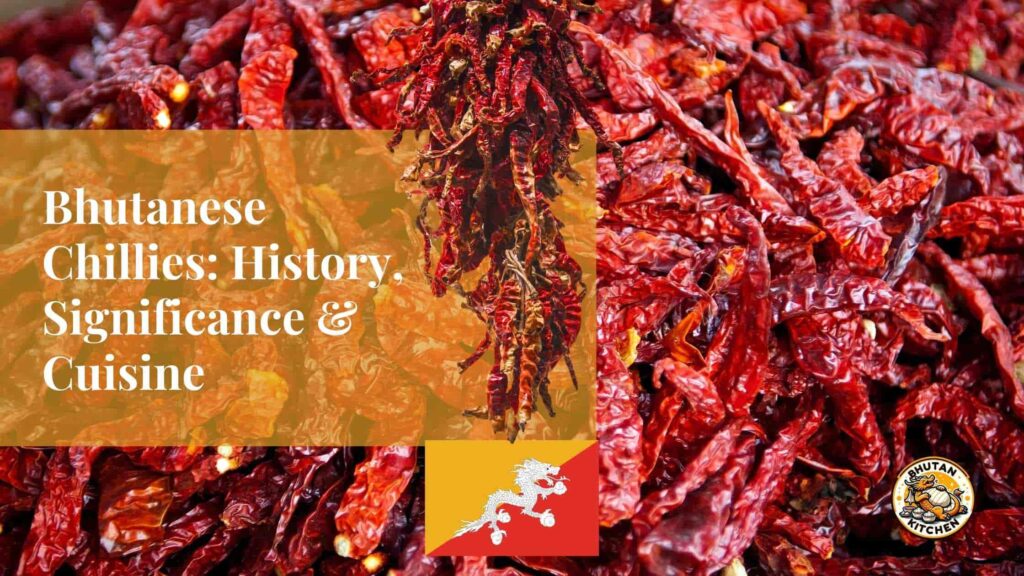Bhutan History: A Tapestry of Tradition, Resilience, and Harmony
Bhutan is a small kingdom nestled in the Eastern Himalayas of around 780,000 people (2022), with India to the south and Tibet (China) to the north. Bhutan’s history traces back to around 2000 B.C., evidenced by archaeological findings of stone tools and megaliths. The earliest inhabitants, believed to be the Monpas (meaning non-Tibetans), also known as the Sharchops, are thought to be Indo-Mongoloids originating from regions in northern India, northern Burma, and Thailand. These groups are primarily located in the southeastern and eastern parts of Bhutan. Historically, the population can be broadly classified into three ethnic categories: the Ngalops, Sharchops, and Lhotsampas. The Ngalops, who form the majority, predominantly reside in the western and central regions and are believed to have Tibetan roots, arriving in the 8th and 9th centuries A.D. with the introduction of Buddhism. Their adherence to the Drukpa Kagyupa school of Mahayana Buddhism has shaped the cultural landscape, with Ngalop norms being established as national standards by the monarchy.
The Sharchops, residing in eastern Bhutan, are considered descendants of the region’s earliest settlers and primarily follow the Ningmapa school of Mahayana Buddhism. Together with the indigenous tribal communities, the Ngalops and Sharchops are collectively referred to as Drukpas, making up approximately 65% of Bhutan’s population. Dzongkha serves as the national language, while English is used for instruction in schools and as an official working language for the government. In contrast, the Lhotsampas, who account for around 35% of the population, are of Nepali descent and immigrated to Bhutan in the 19th and 20th centuries, primarily settling in the southern foothills as farmers. They speak various Nepali dialects and predominantly practice Hinduism, adding to the rich tapestry of Bhutan’s cultural heritage.
The introduction of Buddhism in the 7th century by Tibetan King Songtsen Gampo marked a profound cultural and spiritual shift, laying the groundwork for the unique identity that Bhutan would cultivate over the centuries. Research from PBS indicates that Buddhism began to spread substantially in the 8th century with the arrival of Guru Padmasambhava, who is revered as the second Buddha in Bhutanese culture.
In the 17th century, the charismatic lama Zhabdrung Ngawang Namgyal unified the country, establishing a dual system of governance that elegantly balanced secular and religious authority. His leadership was pivotal; especially in battle, where Zhabdrung Ngawang Namgyal faced five Tibetan invasions and successfully defeated the combined forces of Tibet, Mongolia, and local rulers in the Battle of Five Lamas (1634), ultimately uniting Bhutan under his rule. His establishment of the Drukpa Kagyu lineage of Buddhism across Bhutan solidified his status as a unifier, hence the title Zhabdrung, which translates to “At whose feet one submits.”
In this article we will go through the different stages of history and overall preservation of Bhutanese heritage and traditions.
Quick Bhutan History Timeline
| Date | Event |
|---|---|
| 2000 – 1500 B.C. | Evidence of early human habitation in Bhutan, including stone tools and megaliths. |
| 7th Century A.D. | Introduction of Buddhism to Bhutan by Tibetan King Songtsen Gampo. |
| 747 A.D. | Guru Padmasambhava (Guru Rinpoche) arrives, establishing Buddhism more deeply in Bhutan. |
| 9th Century A.D. | The establishment of various monasteries as Buddhism begins to take root. |
| 1616 | Zhabdrung Ngawang Namgyal arrives in Bhutan, marking the beginning of significant unification efforts. |
| 1641 | Zhabdrung defeats the Tibetan army in the famous Battle of Five Lamas, solidifying his control. |
| 1634 | Establishment of the Drukpa Kagyu lineage of Buddhism as the state religion by Zhabdrung Ngawang Namgyal, after the Second Battle of Simtokha Dzong. |
| 1865 | Treaty of Sinchula signed, ceding the Duar plains to British India in exchange for an annual subsidy. |
| 1907 | Ugyen Wangchuck crowned as the first hereditary King of Bhutan, marking the establishment of the monarchy. |
| 1910 | Treaty of Punakha signed, giving the British control over Bhutan’s foreign affairs. |
| 1953 | The first National Assembly convened in Bhutan. |
| 1972 | King Jigme Dorji Wangchuck dies and is succeeded by his son, Jigme Singye Wangchuck. |
| 1971 | Bhutan joins the United Nations, marking its entry into the international community. |
| 2001 | King Jigme Singye Wangchuck initiates the drafting of Bhutan’s first constitution. |
| 2008 | Adoption of the constitution and the first democratic elections held in Bhutan. |
| 2013 | Second democratic elections held in Bhutan, further consolidating its democratic practices. |
| 2016 | The first-ever formal visit by an Indian Prime Minister, strengthening Bhutan-India relations. |
Early Inhabitants and Cultural Roots (2000 – 1500 B.C.)
The early history of Bhutan is characterized by rich mythology and remains somewhat enigmatic, with evidence suggesting it was inhabited as early as 2000 B.C. The earliest inhabitants, believed to be the Monpas, practiced animism and relied heavily on local flora and fauna for sustenance. According to the Gale Group in 2001, it is thought that Bhutan was populated by migrants from Tibet during this time. However, much of Bhutan’s early history remains shrouded in mystery, and significant cultural developments did not occur until the introduction of Tibetan Buddhism in the 9th century A.D., which profoundly influenced the region’s social and spiritual landscape.
Buddhism and Its Influence (7th – 9th Century A.D.)
The introduction of Buddhism in the 7th century by Tibetan King Songtsen Gampo marked a significant cultural shift. This period saw the arrival of Guru Padmasambhava in the 8th century, who assimilated local beliefs into Buddhism. The culinary practices during this time began to incorporate more vegetarian elements, influenced by Buddhist teachings on compassion and non-violence.
Unification Under Zhabdrung Ngawang Namgyal (1616 – 1641)
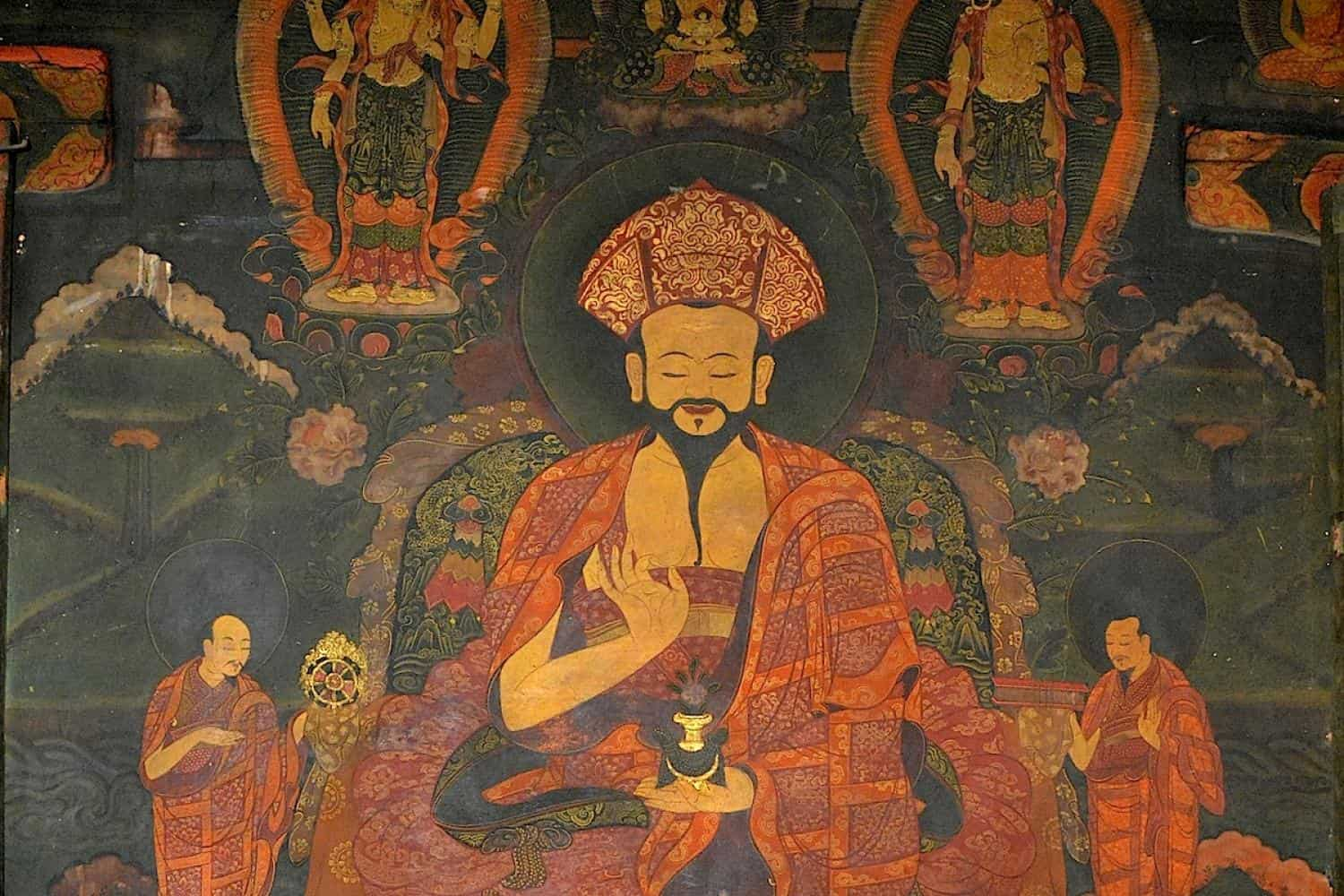
In 1616, the charismatic Zhabdrung Ngawang Namgyal arrived in Bhutan, leading to the unification of the country. His successful defense against Tibetan invasions during the Battle of Five Lamas in 1641 established him as a national figure. This era also saw the construction of dzongs, which served as centers for governance and cultural exchange.
What traditional dishes emerged during Zhabdrung’s era?
During this period, dishes such as ema datshi (chili and cheese) began to gain prominence, reflecting the use of locally sourced ingredients and dairy products from yak herding communities.
The Establishment of the Dual System of Governance (17th Century)
Zhabdrung instituted a dual system of governance, dividing power between the religious leader (Je Khenpo) and the secular leader (Druk Desi). This system stabilized the country and allowed for the flourishing of cultural practices, including culinary traditions. Festivals, such as tshechus, became important social events where traditional foods were prepared and shared.
The Impact of British Influence (19th Century)
The 19th century brought British influence, culminating in the Treaty of Sinchula in 1865, which ceded territory to the British. Bhutan’s culinary practices were impacted by trade with the British, introducing new ingredients and cooking techniques. However, Bhutan maintained its culinary identity, focusing on the use of local produce and traditional spices.
What changes occurred in Bhutanese cuisine due to British interactions?
British interactions introduced new techniques and ingredients, but Bhutanese cuisine remained rooted in local traditions. The introduction of tea and other imported goods influenced social practices around food.
The Establishment of the Monarchy and Modernization (20th Century)
In 1907, Ugyen Wangchuck was crowned as the first hereditary King of Bhutan, marking the establishment of the monarchy. This period saw modernization efforts, including infrastructure development, which influenced food accessibility and culinary diversity. Traditional Bhutanese foods continued to thrive, with a focus on sustainability and local sourcing.
The Transition to Democracy (21st Century)
The early 21st century marked a significant transition to democracy, culminating in the adoption of Bhutan’s first constitution in 2008. This period emphasized cultural preservation, including culinary heritage. Bhutan’s commitment to Gross National Happiness (GNH) also extended to food sovereignty, promoting local agriculture and traditional cooking methods as a means of sustaining cultural identity.
The Preservation Of Bhutanese Heritage And Traditions
The country’s efforts to preserve its heritage are evident in various aspects of its society, from its architectural marvels to its vibrant festivals and the continued practice of age-old customs. They also reject consumerism with no franchising allowed, so you won’t find a McDonalds for example.
Architecture
One of the most striking examples of Bhutan’s dedication to preserving its heritage is the maintenance of its traditional architecture. The dzongs, which are fortress-monasteries, stand as monumental symbols of Bhutanese culture and history. These structures, characterized by their massive stone walls, intricate woodwork, and ornate decorations, serve both religious and administrative purposes. The government has implemented strict regulations to ensure that new constructions adhere to traditional architectural styles, thereby preserving the aesthetic continuity of the landscape. This commitment to architectural preservation not only safeguards the physical manifestations of Bhutanese heritage but also reinforces a sense of national identity and pride among its citizens.
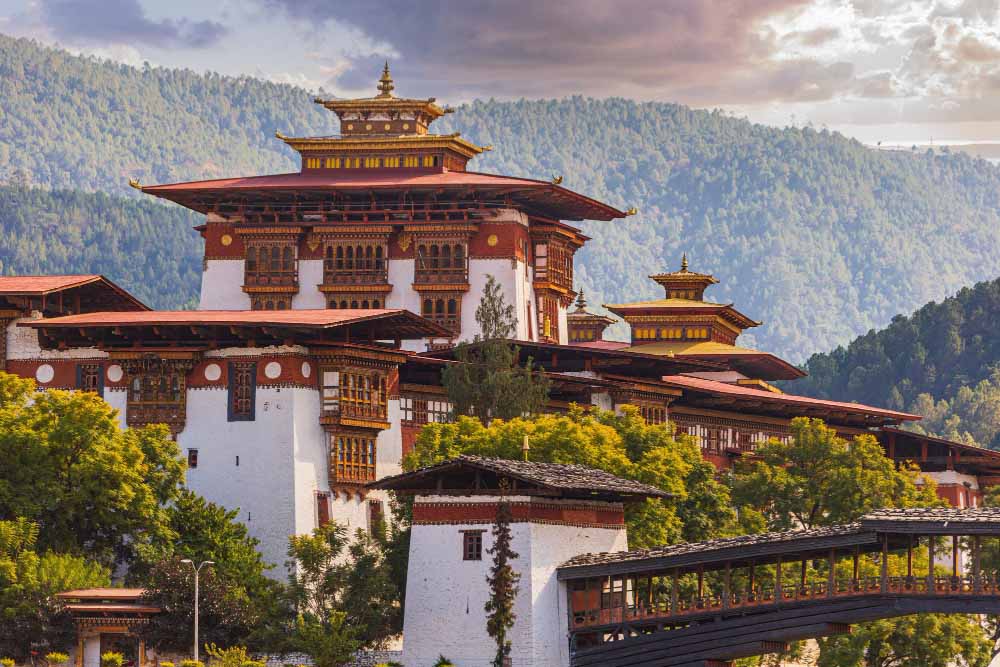
Culture
Bhutan places great emphasis on the celebration of its cultural festivals, known as tshechus. These festivals, held annually in various regions, are vibrant displays of Bhutanese spirituality and communal harmony. Tshechus feature masked dances, traditional music, and religious rituals, all of which are performed to honor Guru Rinpoche, the revered Buddhist saint who is credited with introducing Buddhism to Bhutan. The government actively supports these festivals, recognizing their role in fostering social cohesion and transmitting cultural values to younger generations. By ensuring that these festivals remain an integral part of Bhutanese life, the nation preserves its intangible cultural heritage and strengthens the bonds within its communities.
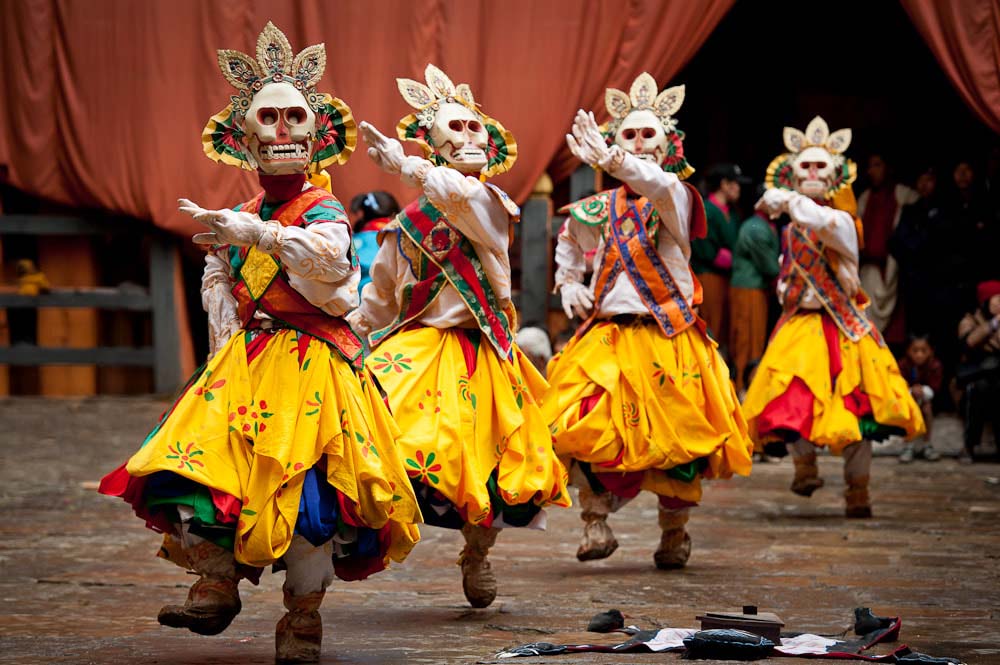
Food
Bhutan’s approach to cuisine is not just about maintaining traditional recipes; it is also about nurturing a connection to the land, local resources, and community. With franchising and globalization largely rejected, Bhutan promotes local businesses and traditional food practices, ensuring that Bhutanese cuisine remains authentic and vibrant.
One of the cornerstones of Bhutanese cuisine is its reliance on local ingredients. The country’s diverse agro-ecological zones allow for a variety of seasonal foods, but the challenges of rural isolation mean that many families often rely on staple crops, primarily potatoes and chilies (Kewa Datshi). While these staples are essential to the national diet, efforts are being made to diversify food sources and improve nutritional outcomes, particularly for vulnerable populations such as pregnant women and young children. Initiatives led by the Ministry of Agriculture and Forests aim to enhance nutrition during critical developmental periods, promoting the cultivation of a wider array of fruits and vegetables. Adversely, Bhutan’s constitution mandates that 60 percent of its national land be preserved under forest cover, making it harder as fertile land is sparce in these geographic conditions.
Ema Datshi, the national dish of Bhutan, exemplifies this preservation effort. Made from local green chilies and cheese, it is a dish that not only satisfies the palate but also reflects the agricultural practices of Bhutan. Similarly, dishes like Phaksha Paa (pork with chilies) and Jasha Maru (spicy chicken curry) highlight traditional cooking methods that have been passed down through generations.
Language and Literature
Dzongkha, the national language, is a crucial element of Bhutan’s cultural identity. The government has implemented policies to promote the use of Dzongkha in education, media, and official communications. This linguistic preservation is complemented by efforts to document and disseminate Bhutanese literature, which encompasses religious texts, historical chronicles, and folk tales. These literary works provide valuable insights into the nation’s past and serve as a repository of collective wisdom and cultural knowledge.
Environmental conservation
The country’s philosophy of Gross National Happiness (GNH) emphasizes the importance of environmental sustainability as a pillar of national well-being. Bhutan has implemented policies to protect its forests, wildlife, and natural resources, recognizing that the natural environment is inextricably linked to its cultural heritage. The preservation of sacred sites, such as mountains, rivers, and forests, is deeply rooted in Bhutanese spiritual beliefs and practices.
Through these efforts, Bhutan has managed to maintain its unique cultural identity while navigating the challenges of modernization. The nation’s commitment to preserving its heritage serves as an inspiration to other countries seeking to balance tradition and progress. As Bhutan continues to uphold its rich cultural legacy, it ensures that future generations will inherit a vibrant and enduring heritage.
Q&A
When did Bhutan first unify as a nation?
Answer: Bhutan was first unified as a nation in the early 17th century by Ngawang Namgyal, the Zhabdrung Rinpoche. Arriving in Bhutan in 1616, Zhabdrung faced significant challenges, including internecine conflicts among local chieftains and external threats from Tibetan forces. Through strategic military victories, including the famous Battle of Five Lamas in 1641, he successfully consolidated power, establishing a centralized authority. Zhabdrung’s efforts not only unified Bhutan politically but also laid the foundation for a distinct national identity, characterized by the promotion of the Drukpa Kagyu school of Buddhism as the state religion.
What is the significance of the year 1907 in Bhutanese history?
Answer: In 1907, Ugyen Wangchuck was crowned as the first hereditary King of Bhutan, marking a pivotal moment in the country’s transition from a theocratic government to a constitutional monarchy. This establishment of the monarchy provided a stable and continuous leadership that was crucial for maintaining internal cohesion and addressing external challenges. Ugyen Wangchuck’s reign initiated a period of modernization while preserving Bhutan’s cultural heritage, setting the stage for future development and diplomatic relations, particularly with British India.
Which treaty established Bhutan’s relationship with British India?
Answer: The Treaty of Punakha, signed in 1910, established Bhutan’s relationship with British India. Under this treaty, Bhutan agreed to allow the British to control its foreign affairs, while the British recognized Bhutan’s independence and territorial integrity. This agreement marked a shift from conflict to cooperation, allowing Bhutan to maintain a degree of sovereignty while benefiting from British support. The treaty also laid the groundwork for future diplomatic relations and influenced Bhutan’s foreign policy in the years to come.
When did Bhutan join the United Nations?
Answer: Bhutan joined the United Nations on September 21, 1971. This event marked Bhutan’s entry into the international community and was a significant step towards greater global engagement. Joining the UN allowed Bhutan to participate in international discussions and initiatives, aligning with its commitment to promoting peace, development, and cultural preservation. The decision to join was also reflective of Bhutan’s evolving political landscape under King Jigme Singye Wangchuck, who favored modernization and international cooperation.
What major political change occurred in Bhutan in 2008?
Answer: In 2008, Bhutan transitioned from an absolute monarchy to a constitutional monarchy, culminating in the adoption of its first democratic constitution. This significant political change was marked by the first democratic elections held in March 2008, where citizens voted for their representatives in a parliamentary system. The new constitution enshrined fundamental rights and freedoms, established a bicameral legislature, and emphasized the importance of preserving Bhutan’s unique cultural heritage and promoting Gross National Happiness (GNH). This transition was a landmark moment in Bhutan’s history, reflecting the monarchy’s commitment to democratic governance while maintaining cultural continuity.
Who was the first democratically elected Prime Minister of Bhutan?
Answer: Jigmi Y. Thinley was the first democratically elected Prime Minister of Bhutan, taking office in 2008 following the first democratic elections. Thinley, a member of the Druk Phuensum Tshogpa party, played a crucial role in the transition to democracy and was instrumental in implementing policies that aligned with the principles of Gross National Happiness. His leadership marked a significant shift in Bhutan’s political landscape, fostering greater citizen participation in governance and addressing key issues such as sustainable development and social equity.
What were the major conflicts Bhutan faced during the 18th and 19th centuries?
Answer: During the 18th and 19th centuries, Bhutan faced several conflicts, most notably the Duar Wars against British India in the 1860s. These conflicts arose from territorial disputes over the fertile Duar plains. The culmination of these conflicts led to the Treaty of Sinchula in 1865, where Bhutan ceded significant territory to the British. The internal power struggles among local chieftains also contributed to the instability of the period.
How did Zhabdrung Ngawang Namgyal influence Bhutan’s religious landscape?
Answer: Zhabdrung Ngawang Namgyal played a crucial role in establishing the Drukpa Kagyu school of Buddhism as the state religion, integrating Buddhist principles into governance. His leadership not only unified the country but also fostered a sense of national identity rooted in Buddhism. He constructed numerous dzongs (fortress-monasteries), which served as both religious and administrative centers, reinforcing the connection between governance and spirituality.
What role did Bhutan’s geography play in its historical development?
Answer: Bhutan’s rugged geography, characterized by mountainous terrain and deep valleys, has significantly influenced its historical development. The natural barriers provided protection from invasions, allowing Bhutan to maintain its sovereignty for much of its history. Additionally, the geography facilitated the development of distinct regional cultures and culinary practices, as different valleys had varying access to resources and trade routes.
What was the impact of the 1972 transition in leadership on Bhutan’s modernization?
Answer: The transition of leadership in 1972, when King Jigme Singye Wangchuck ascended the throne, marked the beginning of a new era of modernization in Bhutan. King Jigme Singye Wangchuck implemented policies aimed at improving education, health care, and infrastructure while emphasizing the preservation of cultural heritage. His vision led to the introduction of Gross National Happiness as a guiding philosophy for development, prioritizing the well-being of the Bhutanese people over mere economic growth.
How has Bhutan’s approach to environmental conservation evolved over time?
Answer: Bhutan has long recognized the importance of environmental conservation, rooted in its Buddhist beliefs that emphasize the interconnectedness of all life. Over time, this approach has evolved into a formal commitment to sustainable development, highlighted by Bhutan’s unique philosophy of Gross National Happiness. Policies have been implemented to protect forests, promote renewable energy, and maintain biodiversity, making Bhutan one of the few carbon-negative countries in the world.

